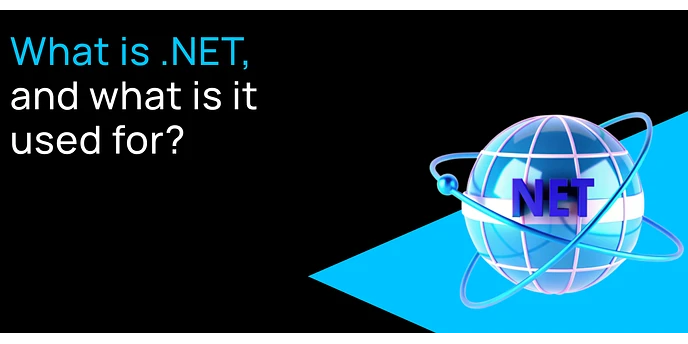What is .NET, and What is It Used For?

Introduction
.NET is a free, open-source development platform created by Microsoft. It allows developers to build a variety of applications, including web and mobile apps, cloud-based solutions, games, and IoT systems. The platform supports multiple programming languages and provides a robust ecosystem of tools for development, testing, and deployment across different platforms. The primary language used with .NET is C#.
With its flexibility and scalability, .NET is widely used in enterprise environments, supporting large-scale applications that require high performance, security, and maintainability. Additionally, .NET enables cross-platform development, making it a valuable choice for modern software development needs.
Also interesting:
Learn PHP with our free course!!
The Evolution of .NET
Microsoft introduced the .NET Framework in 2002 as a foundation for Windows application development, offering pre-built libraries and tools. In 2016, they launched .NET Core—a lightweight, modular version designed for cross-platform development. Since then, .NET has undergone significant improvements, unifying its ecosystem under .NET 5 and later versions.
Key Differences Between .NET Framework and .NET Core:
- .NET Framework – Primarily designed for Windows applications, supporting legacy software and enterprise solutions.
- .NET Core – A cross-platform, high-performance framework with better memory management and scalability.
Currently, Microsoft supports four main .NET variants:
- .NET 5 and later – The unified platform for modern application development.
- .NET Framework – Legacy framework for Windows-based applications.
- Mono – A lightweight runtime for mobile and embedded applications, used with Xamarin.
- UWP (Universal Windows Platform) – Enables applications to run across multiple Windows-based devices, including IoT and embedded systems.
Core Components of the .NET Platform
Regardless of the .NET version used, developers work with several essential components:
- Common Language Runtime (CLR) – The execution environment that manages memory allocation, garbage collection, and exception handling.
- Class Libraries – A comprehensive set of pre-built functions for file handling, networking, database operations, and data processing.
- Development Tools – IDEs like Visual Studio and Visual Studio Code provide extensive debugging, testing, and deployment features.
- Application Frameworks – Includes ASP.NET for web development, Windows Forms for desktop applications, and Xamarin for mobile development.
Programming Languages Supported by .NET
.NET supports multiple programming languages, allowing developers to choose the best fit for their projects:
- C# – The primary language for .NET development, offering a balance of power and simplicity.
- F# – A functional-first programming language used for data science, finance, and analytical tasks.
- Visual Basic – Known for its readability and ease of use, often used in enterprise applications.
Read also:
What is Golang, and What is It Used For?
Applications of .NET
Thanks to its cross-platform capabilities and high performance, .NET is used in various industries and application types:
Web Development
.NET Core enables the creation of fast, scalable, and reliable web applications, REST APIs, and microservices. Some notable examples include:
- Stack Overflow – A leading Q&A platform for developers.
- Microsoft Teams – A collaboration and communication tool used worldwide.
- UPS Tracking System – A real-time package tracking system for global logistics.
Desktop Application Development
.NET supports the development of powerful Windows desktop applications using WPF (Windows Presentation Foundation) and Windows Forms. Examples include:
- Visual Studio – Microsoft’s flagship integrated development environment (IDE).
- Paint.NET – A lightweight image editing software built with .NET.
- Enterprise Business Solutions – Various warehouse management and point-of-sale systems.
Mobile Development
Using Xamarin, now integrated into .NET, developers can create native mobile applications for iOS and Android from a single codebase. Some applications built with Xamarin include:
- UPS Mobile – A package tracking application.
- Alaska Airlines – An airline app providing booking and travel management features.
Game Development
.NET plays a significant role in game development, particularly through the Unity engine, which supports C#. Notable games built with Unity include:
- Pokémon Go – A popular augmented reality mobile game.
- Terraria – A 2D sandbox game powered by C# and .NET.
- Hearthstone – A collectible card game by Blizzard, developed using Unity.
Cloud Computing
.NET is ideal for building cloud-based applications, particularly when leveraging Microsoft Azure. It supports microservices, data analytics, and machine learning workloads. Key examples include:
- Azure DevOps – A platform for CI/CD and software lifecycle management.
- .NETflix – A component of Netflix’s server architecture is powered by .NET technologies.
Internet of Things (IoT)
.NET facilitates the development of IoT applications, enabling automation and real-time analytics. Common use cases include:
- Smart Building Management Systems – Automating lighting, heating, and security in commercial buildings.
- Industrial Equipment Monitoring – Enhancing efficiency and predictive maintenance in manufacturing.
Advantages of .NET
.NET continues to be a preferred development platform due to its numerous advantages:
- High Performance – Optimized runtime ensures minimal latency and efficient execution.
- Cross-Platform Support – Develop applications that run on Windows, macOS, Linux, iOS, and Android.
- Security and Reliability – Features like data encryption, authentication, and access control enhance security.
- Extensive Ecosystem – A vast collection of libraries and development tools available through NuGet accelerates development.
- Strong Developer Community – Extensive documentation, tutorials, and an active community make learning and troubleshooting easier.
Conclusion
.NET is a powerful, flexible, and scalable platform for developing applications across multiple domains. Its versatility, security, and strong community support make it a leading choice for developers worldwide. Whether you’re building enterprise applications, web services, cloud solutions, or mobile apps, .NET provides the necessary tools and frameworks to bring your ideas to life. For those interested in learning .NET, structured courses from Hexlet provide guided learning paths with free access to essential materials.
Валерия Белякова
10 months ago

What is .NET, and What is It Used For?
Discover Microsoft’s .NET platform for building web applications, games, cloud solutions, and IoT projects. Learn about its key benefits, supported programming languages, and real-world applications.
10 months ago
0
~time.minutes

What is Golang, and What is It Used For?
Discover what Golang is, how it was created, its key applications, advantages, and code examples, as well as its relationship to the C programming language. A beginner-friendly overview.
10 months ago
2
~time.minutes